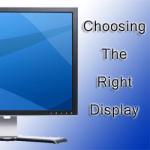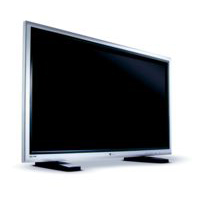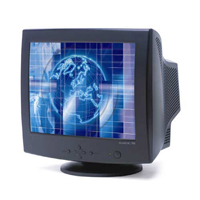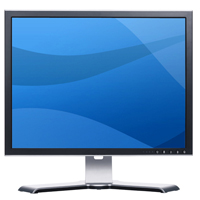
What the heck is a...?
A computer display, also called a monitor, is the screen people use to view images and interface with their PC. There are a few different hardware technologies that display output generated by your computer, but the three main ones are:
- Plasma, the newest, most hyped-up technology, usually chosen for televisions as opposed to computer displays
- CRT (cathode ray tube) this was formerly the most popular monitor and uses a picture tube, like many televisions before new millennium technology
- LCD (liquid crystal display) is the most popular display purchased for new computers and receives computer and television output

Advantages and Disadvantages of Plasma
Plasma displays are more frequently used for home entertainment, but there are also plasma displays that accept computer output. Advanced technology involving ionized gas, UV radiation and color phosphors to create the images on the screen. A plasma display is an unnecessary expense for personal and business use in most instances. An LCD screen offers a sharp, effective display at a much more realistic price for models under 42”. CRT monitors can provide a screen that with true colors and images that come up quickly (games like this because you have no trails on the screen).
The hype about plasma is the thinness of the display and the alleged range of colors visible on the screen. You can get a thin display and super color for a lot less cash so don't get sucked in by that salesperson at Circuit City.
 Advantages and Disadvantages of CRT
Advantages and Disadvantages of CRT
CRT is the older type of monitor around, and is often preferred by graphic designers and gaming junkies because of the rich color and great range of resolution. This display is like a television tube with a moving electron beam in a tube that sweeps images into a screen. CRT displays are heavy, take up space and use a decent amount of energy but offer good results for a low price.
Size: The size of the monitor is not really the size of what's displayed because the tube is usually covered by the screen casing. The manufacturer states a measurement for the viewable area, which is what is actually visible to you when you look at the screen. For example, a 17” screen may have a 15” visibility. CRT displays come in sizes from 15” to 21” and higher, with 17” and 19” being the most popular sizes chosen. Consider how much space you have for the display and what the computer will be used for to figure out what size display works best for you.
Screen: Although CRT displays were traditionally rounded, now there are also flat screens available at very reasonable prices.
Resolution: As you set your resolution higher, things on the screen will look smaller. Your graphics card and resolution capability of your monitor should be compatible. Commonly used resolutions include 800 x 600 (SVGA), 1024 x 768 (XGA), 1280 x 1024 (SXGA) and 1600 x 1200 (UXGA). A 17” display will usually support SXGA and some can even handle UXGA, so choosing a size between 17” and 19” is usually best and cheapest for personal use. Anything bigger than 19”, the sweet spot for value and performance, is really a waste.
Refresh rate: The refresh rate is how often the screen gets redrawn each second. A display with a rate lower than 75 Hz is usually detectable and can cause eye fatigue.
Brightness: This is important to adjust for visual comfort and it usually isn't quite right coming from the factory. Most displays have buttons on the front, much like a television, that let you adjust the contrast and brightness.
Continue to page 2 >> [[page]]
Advantages and Disadvantages of LCD
LCD displays have become most popular because they are extremely lightweight, offer optimal text viewing, don't flicker and usually use a lot less energy. These displays actually started out on laptops and are now flat-panel monitors that are becoming quite affordable. LCD technology involves a illuminating patterns of crystals as the electronic current is turned off and on.
Size: LCD displays are sold by actual screen dimensions, which measure the displayable area from the lower corner to the upper corner of the screen. Additionally, you need to consider the aspect ratio when choosing an LCD display. Most LCD displays have an aspect ratio of 3:4, like regular televisions. The wider screen monitors, however, are similar to HDTVs that have a 16:9 aspect ratio. The diagonal measurement is the real measurement from the viewable screen. Sizes ranging from 14” to 24” and higher are available and once again, 17” and 19” sizes are most popular.
Screen: LCD displays are very light with flat screens. With LCD displays, you need to think of the viewing angle. Much like rear projection displays you have to sit directly in front of, images can deteriorate on LCD screens depending on the angle you view them from. A higher angle of 150 degrees or more is preferred to be able to fully view the screen from the front.
Resolution: LCD displays have native resolution, which can actually only display a single given resolution. For example, a 15” has a native resolution of 1024 x 768 and LCDs between 17” and 19” use a 1280 x 1024 resolution. The 23” and 24” wide-screen LCDs have a native resolution of 1920 x 1200. The most popular sizes in between have a resolution of 1680 x 1050. You cannot display a 1280 x 1024 resolution on an LCD display with a native resolution of 1024 x 768. However, you can buy LCD monitors at varying resolutions in a variety of sizes.
Refresh rate: Refresh rate is the response time for the crystals in LCD displays to rise and fall to create images. Refresh rates are measured different depending on the manufacturer, but are typically white to black to while or gray to black to white. Because refresh rates are sometimes slow, a blurring effect can occur. Less blurring happens when there is a lower response time.
Brightness: LCD screen are typically brighter than most CRT displays and have adjustment buttons for contrast and brightness on the display. Usually brightness levels on new LCD displays need to be turned down.
Costs and Cutting to the Chase
Both CRT and LCD displays are affordable, with CRT displays ranging in price from $100 to $500, and LCD typically starting at $150 and going up from there. LCD displays are light, functional and fit almost anywhere for people who need to save space yet want maximum functionality. CRT displays are bigger and bulkier, but offer folks involved with graphics or gaming quicker screens and super color, as well as flexibility to change the resolution without compromising the quality of the images. You can purchase a variety of quality CRT displays for under $200. I personally recommend Dell because they offer a great product and excellent service, though I also happen to find that IBM offers a decent product.
Like the old saying goes, bigger is not necessarily better – it's how you intend to use it. Get only what you need and don't be sold on the widest, flattest display in the store. Figure out what you need the monitor to do, then find the one works for you while best fitting into your budget.





